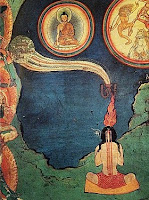 |
| Summer on the desolate "Rooftop of the World" |
Naturally, being an American with some fancy technology, I wanted to photograph them in the eerily clear atmosphere on the rooftop of the monastery on the Rooftop of the World, overlooking the backside of Mt. Everest and its neighboring mammoth mountains. This sent them into a panegyric. But what they were saying was not that I was great.
 |
| Why Thikse? To snap this Buddha |
(They must have originally thought I had an instant camera, which they must have seen do its magic because they sure seemed to want the rare aristocratic opportunity to behold themselves in portraits. By now, they probably all have smartphones with Elon Musk and Bill Gates providing Internet access. Ah, to return and see them all grown up like these explorers managed to do).
I found myself alone in Thikse's meditation hall in front of Maitreya, which is odd in India no matter where or when one goes. This is the best Maitreya statue, but it's too tall to be indoors. The only way to get a full picture of it (because, look, one is only seeing the upper half) is to paste a photo taken of it downstairs to one taken of it upstairs. Looking around, I noticed a little door, a hatch, a mysterious portal. And as any Ugly American might, I decided to follow it without permission. How many mysterious portals does one ever get to enter in life?
Behind the wooden glitz and ancient glamor of the meditation hall, it was dark and creepy, a sooty, abandoned construction site. (Don't read on as it only encourages exploratory nosiness and writing about it). CONTINUED BELOW
Hidden Tibetan Buddhist monastery | Our World: Return to Zanskar | BBC documentary
 |
| Entrance to the Himalayan monastery |
This is a region lost in time with centuries old monasteries (gompas or lamaseries) built into rock faces and caves.
 |
| Magic and mystery: tummo practice |
The filmmakers end up at one of the most stunning Buddhist monasteries on the Zanskar River, Phuktal Monastery (not pronounced \F*ck-Tall\ like it looks but \pook-tal\, which means "Cave of Liberation"), sometimes spelled Phugtal or Phukthar Monastery.
 |
| Thikse has the best Maitreya statue |
Here in Ladakh the filmmakers observe a unique prayer ceremony and speak to Buddhist monks who have lived in seclusion for decades, striving for awakening and liberation.
#buddhism #zanskar #zanskarvalley #tibet #tibetanmusic #philosophy #tibetanbuddhism
Beyond the Portal
 |
| What was hung out to preserve on a sawhorse? |
Through the poor light, I began to discern a jerkified carcass. Donner Rugby Party? It was shriveled and being stripped off piece by piece, propped up on the sawhorse in violation of the Monastic Disciplinary Code I was familiar with. It's a violation to keep food in one's room. Who killed it? Maybe it was found dead? Maybe workers and guests stayed here?
 |
| Listen to Led Zep in Kashmir on way to Ladakh |
Fortunately, things are improving in the Himalayas as Tibetan Buddhist nuns turn to compassionate vegetarianism.
How could an American be so nosy? Who else would be? On that same trip, I attended an ancient dance ceremony inside Hemis Monastery (the place where Jesus of Nazareth stayed and trained when Jesus was a Tibetan Buddhist monk). Now imagine if I had seen any hatches and followed them into the monastic library or seen paintings and paraphernalia of the West's religious idol? I could have been the new Nicolas Notovitch.
- 'Society of the Snow' [on soccer cannibals] is among Netflix's biggest non-English movies ever (variety.com)
HEMIS FESTIVAL: The most esoteric festivities include the mystic mask dances of Ladakh, collectively referred to as chams performances, an essential part of Tantric tradition, performed only in those gompas that follow the Tantric Vajrayana teachings, where monks perform tantric worship.
Fully ordained Buddhist monks dance?
I'm not excusing it; I'm just saying: If nosy Westerners don't poke around for information and report on it, who will? Swamis? We're the current version of the Roman Empire.
- Danny Bull (BBC, 2/11/23); Dhr. Seven, Pat Macpherson, Amber Larson (eds.), Wisdom Quarterly


















































































































































































































































No comments:
Post a Comment